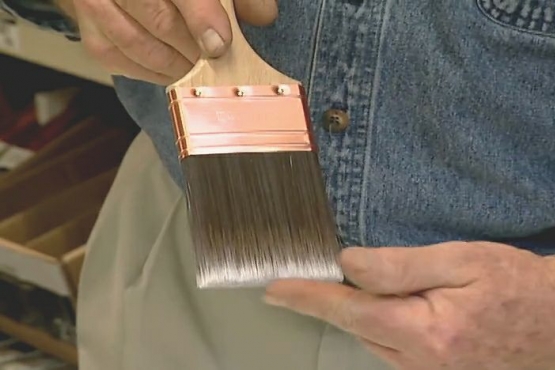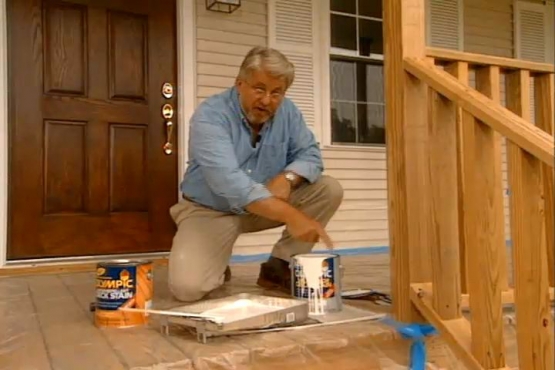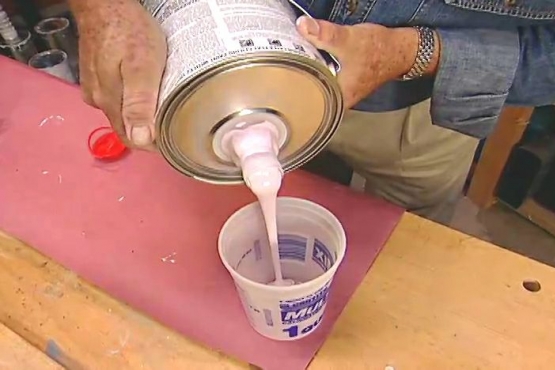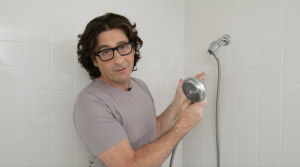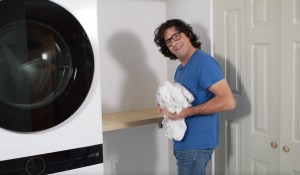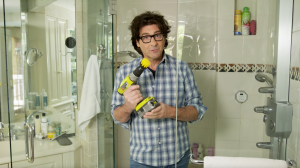RON HAZELTON:
The other day I was downtown having lunch at the Super Duper Weenie when up pulls this car and there's a sign on the side. It says Custom Works. Decorative painting and interiors. And I go hey, I wonder if these people do faux finishes.
So I go up, I tap on the window, hi, the window rolls down and inside are Cheryl and Julie, I dubbed them the Faux sisters and that's what they do. Faux finishes. So I asked if they'd come over and I particularly want to learn one of the trowel finishes.
You know one of the ones that have pretty heavy texture.
WOMAN:
Ron, we're giving you an apron so you don't get messy.
RON HAZELTON:
Really? I'm a messy person to begin with so it's probably a good thing.
WOMAN:
This is a textured paint made by Behr.
RON HAZELTON:
So this is actually paint?
WOMAN:
Yes.
RON HAZELTON:
Boy, it's very thick, isn't it.
WOMAN:
Thickened. It's like a peanut butter consistency.
RON HAZELTON:
It looks almost like thinned down -
WOMAN:
Joint compound, yeah.
[BOTH SPEAK AT ONCE]
RON HAZELTON:
Yeah.
WOMAN:
Absolutely.
RON HAZELTON:
Texture paint commonly used to hide wall and ceiling imperfections is reinforced with interwoven fibers to resist cracking and bonds well to surfaces that have been previously painted. The Faux sisters have me apply the textured paint using a trowel with rounded ends, designed for applying cement to the curved surfaces of swimming pools. Actually did you know my father was a plasterer?
WOMAN:
Then you should be good at this.
RON HAZELTON:
Yeah. I've never used a pool trowel before.
WOMAN:
It's almost on a 45 degree angle - while you're dragging the plaster around or the stucco - it's a fast technique because with this larger trowel, you can cover a lot of area in a short amount of time.
RON HAZELTON:
For learning purposes, I'm working on this test panel. Once my skills are honed, I can think about doing this on one of my walls. Now for the texture part. To get the desired effect, I need to flatten the trowel and sort of drag it over the surface.
WOMAN:
Let it grab a little.
RON HAZELTON:
Let it grab a little.
WOMAN:
Yeah.
RON HAZELTON:
Almost flat?
WOMAN:
Almost -
WOMAN:
A little flat. You can give it a little bit of an angle. Otherwise you'll get stuck.
RON HAZELTON:
At times it feels like the tool is skipping, which is why this is sometimes called “skip troweling”. All right, so we'll put this aside. And I know normally you said 24 hours but you, thinking ahead as you do so well, obviously, prepared another one of these beforehand. It's already dry. So we can go on to the next step.
WOMAN:
To the next step, yeah.
RON HAZELTON:
Yeah. It's really, really dry.
[BOTH SPEAK AT ONCE]
And you say this will not flake away like joint compound would.
WOMAN:
No and especially after it's painted which is the next step we're going to do right now.
RON HAZELTON:
Okay. This is, what kind of paint is this? Water base right?
WOMAN:
This is a water based eggshell finish. You can use eggshell or satin -
RON HAZELTON:
But you wouldn't use - there you go again, sat-in.
WOMAN:
No gloss.
RON HAZELTON:
You're a Connecticut girl. I know that. Sat-in.
WOMAN:
How else would I say?
RON HAZELTON:
Satin.
WOMAN:
Sateen.
RON HAZELTON:
But not in, but not in Connecticut. It's Sat-in in Connecticut.
WOMAN:
Satin.
RON HAZELTON:
Oh, so this, this should cover everything.
WOMAN:
Everything.
[BOTH SPEAK AT ONCE]
WOMAN:
- completely covered.
RON HAZELTON:
So the long nap is getting down in those recesses there. Okay. And you said this is, this is eggshell. You would not use a flat for this?
WOMAN:
No, I wouldn't.
RON HAZELTON:
Now this is a, this is a water based paint. So normal dryness would be what, maybe an hour?
WOMAN:
Yeah.
RON HAZELTON:
With the base coat down and dry, we're ready to prepare the translucent top coat. We start with a clear water based glazing liquid. Then add concentrated colored pigment. In our case, a medium brown shade to end up with the color we want.
People have suggested using just diluted paint as a glaze. What's the advantage of using a glazing medium and the colors as opposed to just the diluted paint?
WOMAN:
Well the glaze allows you more of an open time than you would have with just a watered down paint.
RON HAZELTON:
Open time meaning it's just stays -
[BOTH SPEAK AT ONCE]
WOMAN:
Yeah a watered down paint would dry very quickly. And if you didn't like the effect you were getting, you'd have to rewash down the whole thing. And wipe it all off and restart again. This allows you to give it a little bit more time on the wall.
RON HAZELTON:
The glaze is applied to the entire surface with a medium nap roller. Once it's on, we take it off. But we don't take it all off.
WOMAN:
So now just take a rag - it's actually a towel that's a rag. Contractor rag towel. And I'm just wiping it off. Kind of in a circle. And you could swish it - go up a little higher with it. See how there's swipe marks in here.
RON HAZELTON:
Yeah, yeah. Those you want to see go away.
WOMAN:
You don't want those. You want to just kind of -
[BOTH SPEAK AT ONCE]
WOMAN:
You don't want to push too hard either. It's a light hand -
RON HAZELTON:
So this is collecting in the, in the low spots or the depressions, right.
WOMAN:
Right. So it's grabbing in all that texture that you've applied. Now after I want to also show you, when you overlap on glaze, you're going to see a little bit of the darker effect if you let it dry too long. Which in some cases it might look nice. It might look like a water -
[BOTH SPEAK AT ONCE]
- weathered water veins, you know it gives it the whole aged effect.
WOMAN:
In certain areas, you might want to push down a little to get more light.
RON HAZELTON:
Oh yeah, oh yeah, oh yeah I see it. It comes up - and then you can -
[BOTH SPEAK AT ONCE]
WOMAN:
The glaze could be a little tricky to work with.
RON HAZELTON:
You prefer the circular motion versus the -the figure 8 motion, right?
WOMAN:
Yeah.
RON HAZELTON:
We'll be, we're done.
WOMAN:
Okay.
WOMAN:
We're finished.
WOMAN:
It has to really cure for about 7 days.
RON HAZELTON:
This really does look like old plaster. As a token of my appreciation, I'd like to take you back down to the Super Duper Weenie and you can have whatever you want. What would your fancy be?
WOMAN:
Thanks. Philly cheese steak please.
RON HAZELTON:
Philly cheese steak.
WOMAN:
I'll have a Chicago dog.
RON HAZELTON:
All right guys. Here's to a job well done, right.
ALL:
Cheers.
RON HAZELTON:
I feel like we’ve come full circle. We met here, we’re eating here.
